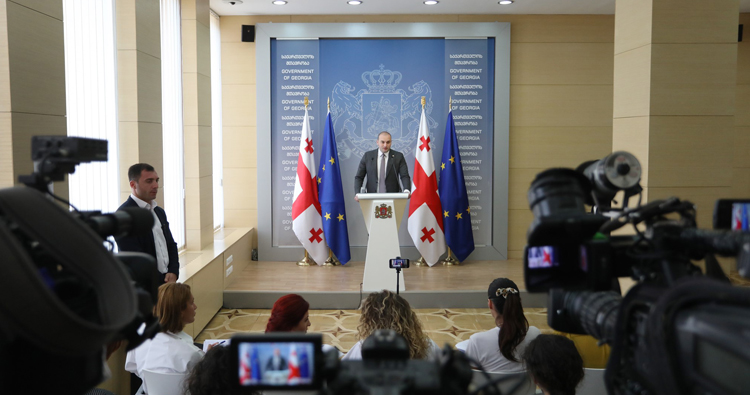Mountain development strategy adopted in Georgia:
What are the priorities for 2019-2023?

The strategy aims to significantly advance living conditions and the demographic dynamics of people living in the mountainous areas of Georgia by 2023. Photo: Nino Alavidze/Agenda.ge.

The government of Georgia has approved the 2019-2023 Strategy for the Development of Georgia's Mountain Settlements in order to ensure equal and sustainable development of Georgian regions, improve living conditions of local population.
The strategy was created by the Georgian Ministry of Infrastructure and Regional Development with the support of the United Nations Development Programme (UNDP), the governments of Switzerland and Austria.
The strategy aims to significantly advance living conditions and the demographic dynamics of people living in the mountainous areas of Georgia by 2023 by improving basic infrastructure, social and public services, tourism attractiveness and by supporting economic activities.
Georgian Prime Minister Mamuka Bakhtadze said that Georgian authorities set the development of Georgian mountain areas as a priority four years ago, and adopted the Law on the Development of Mountain Regions.
 The goal of the strategy is to reduce migration from rural areas to the city by improving living conditions for local people. Photo: Nino Alavidze/Agenda.ge.
The goal of the strategy is to reduce migration from rural areas to the city by improving living conditions for local people. Photo: Nino Alavidze/Agenda.ge.
He said that it was only an initial step, and the government, together with partners, has developed a new, “even more ambitious” 2019-2023 Strategy for the Development of Mountain Settlements that will “boost mountain development in Georgia”.
It is a long-term development strategy that will advance the development of Georgia's highlands to a new level. To make this vision a reality, it is necessary to develop tourism, agriculture, and production in our mountain settlements, also to provide the locals with social assistance through even larger projects, to ensure access to healthcare and other quality services, develop infrastructure, introduce innovative systems, to enhance access to public services, and others”, said Bakhtadze.
 PM Bakhtadze announced that the government adopted new strategy for Georgian mountains at the press-conference after the yesterday's government meeting. Photo: Gov't of Georgia.
PM Bakhtadze announced that the government adopted new strategy for Georgian mountains at the press-conference after the yesterday's government meeting. Photo: Gov't of Georgia.
These are our declared goals, and each is backed up by an action plan involving, among others, increased investments in infrastructure, notably in the construction and rehabilitation of ambulance stations, outpatient clinics, kindergartens, schools, water supply and sewage systems, roads, and tourism infrastructure, also the rehabilitation of monuments of cultural heritage, the creation of a unified electronic system, internet connectivity, and others”, he added.
Four years ago when the Law on the Development of Mountain Regions was adopted 86 million GEL (about $30.23m/€26.96m) was allocated for developing the Georgian highlands.
The money was spent on infrastructural, agricultural and social projects.
Now the forecast budget of the strategy is about 700 million GEL (about $246.05m/€219.46m).
 The latest data show that 1,731 villages have been recognised as high-mountainous settlements in Georgia, where about 245 287 residents benefit from the law. Photo: Nino Alavidze/Agenda.ge.
The latest data show that 1,731 villages have been recognised as high-mountainous settlements in Georgia, where about 245 287 residents benefit from the law. Photo: Nino Alavidze/Agenda.ge.
What has been done for Georgian mountains so far?
Four years ago, on July 16, 2015, when the Law on the Development of Mountain Regions adopted, the National Council for Mountain Development and the Fund for the Development of the Highlands of Georgia were also created. The goal was to reduce migration from rural areas to the city by improving living conditions for local people.
The latest data show that 1,731 villages have been recognised as high-mountainous settlements in Georgia, where about 245 287 residents benefit from the law.
So far 183 million GEL (about $64.32m/€57.37m) has been spent on various social programmes.
More specifically:
- About 15,000 beneficiaries received 23 million GEL (about $8.08m/€7.21m) in total for giving birth to first, second, third and every other child;
- 81,000 beneficiaries received 82.5 million GEL (about $29m/€25.86m) as a pension supplement;
- About 17,000 beneficiaries received 10 million GEL (about $3.51m/€3.14m) as a social supplement;
- 12.3 million GEL (about $4.32m/€3.86m) was allocated for 1,700 medical personnel in supplemental wages;
- 20 million GEL (about $7.03m/€6.27m) was spent to cover energy-related expenses for 90,000 beneficiaries;
- Teachers, trainers received 34 million GEL (about $11.95m/€10.66m) in supplemental wages.
 About 17,000 beneficiaries received 10 million GEL as a social supplement in rural Georgia. Photo: Nino Alavidze/Agenda.ge.
About 17,000 beneficiaries received 10 million GEL as a social supplement in rural Georgia. Photo: Nino Alavidze/Agenda.ge.
Furthermore, over 300 enterprises and 20,000 entities benefited from the tax cuts under the Mountain Law.
As part of the state programme ‘Produce in Georgia’ over 2,000 projects have been financed.
This year the state programme for promoting viticulture agricultural cooperatives will be financed by 2 million GEL (about $0.70m/€0.63m), while young entrepreneurs’s support programme will be financed by 1 million GEL (about $0.35m/€0.31m).
Also this year, 1,220,000 GEL (about $428,822/€382,488) is allocated for the preferential agro-credit project and for the processing enterprise co-financing project.
Since May 2014, the salary of doctors and nurses has been increased by 30 per cent. As of today 1,297 doctors and 1,557 nurses work in the villages of Georgia.
And finally, tens of kilometres of roads are being rehabilitated in mountain settlements every year in Georgia. Construction of large and strategic roads are also planned such as: 28 km Roshka-Arkhoti road, 51.8 km Zemo Imereti-Racha road and Sno-Juta-Roshka-Shatili road.
 Tweet
Tweet  Share
Share